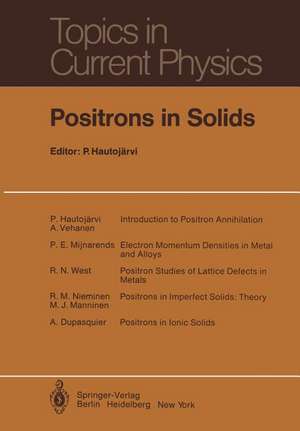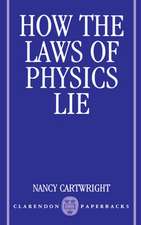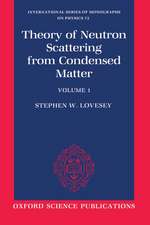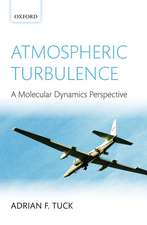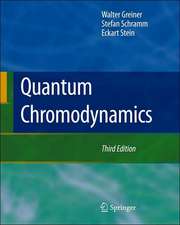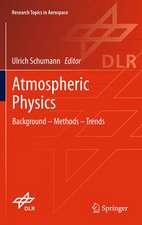Positrons in Solids: Topics in Current Physics, cartea 12
Editat de P. Hautojärvi Contribuţii de A. Dupasquieren Limba Engleză Paperback – 14 dec 2011
Din seria Topics in Current Physics
-
 Preț: 393.13 lei
Preț: 393.13 lei -
 Preț: 401.61 lei
Preț: 401.61 lei - 15%
 Preț: 644.63 lei
Preț: 644.63 lei -
 Preț: 391.99 lei
Preț: 391.99 lei - 15%
 Preț: 642.18 lei
Preț: 642.18 lei -
 Preț: 388.90 lei
Preț: 388.90 lei -
 Preț: 382.95 lei
Preț: 382.95 lei -
 Preț: 398.53 lei
Preț: 398.53 lei -
 Preț: 402.98 lei
Preț: 402.98 lei -
 Preț: 387.96 lei
Preț: 387.96 lei -
 Preț: 388.72 lei
Preț: 388.72 lei -
 Preț: 393.13 lei
Preț: 393.13 lei -
 Preț: 397.38 lei
Preț: 397.38 lei - 15%
 Preț: 642.83 lei
Preț: 642.83 lei -
 Preț: 384.86 lei
Preț: 384.86 lei -
 Preț: 383.33 lei
Preț: 383.33 lei -
 Preț: 385.25 lei
Preț: 385.25 lei -
 Preț: 382.36 lei
Preț: 382.36 lei -
 Preț: 382.36 lei
Preț: 382.36 lei -
 Preț: 382.18 lei
Preț: 382.18 lei -
 Preț: 384.86 lei
Preț: 384.86 lei -
 Preț: 397.59 lei
Preț: 397.59 lei - 15%
 Preț: 639.08 lei
Preț: 639.08 lei -
 Preț: 396.62 lei
Preț: 396.62 lei -
 Preț: 391.40 lei
Preț: 391.40 lei -
 Preț: 382.75 lei
Preț: 382.75 lei -
 Preț: 392.75 lei
Preț: 392.75 lei -
 Preț: 392.60 lei
Preț: 392.60 lei - 15%
 Preț: 643.16 lei
Preț: 643.16 lei -
 Preț: 392.97 lei
Preț: 392.97 lei -
 Preț: 407.01 lei
Preț: 407.01 lei - 15%
 Preț: 638.43 lei
Preț: 638.43 lei -
 Preț: 394.87 lei
Preț: 394.87 lei -
 Preț: 395.09 lei
Preț: 395.09 lei - 15%
 Preț: 641.38 lei
Preț: 641.38 lei -
 Preț: 402.38 lei
Preț: 402.38 lei -
 Preț: 390.63 lei
Preț: 390.63 lei -
 Preț: 387.38 lei
Preț: 387.38 lei -
 Preț: 398.35 lei
Preț: 398.35 lei -
 Preț: 393.35 lei
Preț: 393.35 lei -
 Preț: 384.09 lei
Preț: 384.09 lei - 15%
 Preț: 641.03 lei
Preț: 641.03 lei -
 Preț: 397.01 lei
Preț: 397.01 lei -
 Preț: 395.47 lei
Preț: 395.47 lei - 15%
 Preț: 646.94 lei
Preț: 646.94 lei -
 Preț: 399.67 lei
Preț: 399.67 lei - 15%
 Preț: 642.83 lei
Preț: 642.83 lei - 15%
 Preț: 638.24 lei
Preț: 638.24 lei
Preț: 389.31 lei
Nou
Puncte Express: 584
Preț estimativ în valută:
74.51€ • 77.49$ • 62.35£
74.51€ • 77.49$ • 62.35£
Carte tipărită la comandă
Livrare economică 14-28 martie
Preluare comenzi: 021 569.72.76
Specificații
ISBN-13: 9783642813184
ISBN-10: 3642813186
Pagini: 276
Ilustrații: XIV, 258 p.
Dimensiuni: 170 x 244 x 14 mm
Greutate: 0.45 kg
Ediția:Softcover reprint of the original 1st ed. 1979
Editura: Springer Berlin, Heidelberg
Colecția Springer
Seria Topics in Current Physics
Locul publicării:Berlin, Heidelberg, Germany
ISBN-10: 3642813186
Pagini: 276
Ilustrații: XIV, 258 p.
Dimensiuni: 170 x 244 x 14 mm
Greutate: 0.45 kg
Ediția:Softcover reprint of the original 1st ed. 1979
Editura: Springer Berlin, Heidelberg
Colecția Springer
Seria Topics in Current Physics
Locul publicării:Berlin, Heidelberg, Germany
Public țintă
ResearchCuprins
1. Introduction to Positron Annihilation.- 1.1 Positron Method.- 1.2 Annihilation of Free Positrons.- 1.3 Experimental Techniques.- 1.4 Positroniurn Formation and Annihilation.- 1.5 Topics of Positron Studies.- 1.6 Summary.- References.- 2. Electron Momentum Densities in Metals and Alloys.- 2.1 Theory.- 2.2 Wave Functions.- 2.3 Experimental Techniques.- 2.4 Momentum Density Work in Metals.- 2.5 Disordered Alloys and Ordered Metallic Compounds.- 2.6 Conclusion.- References.- 3. Positron Studies of Lattice Defects in Metals.- 3.1 Annihilation Parameters for Defect Studies.- 3.2 Monovacancies in Equilibrium.- 3.3 Nonequilibrium Studies.- 3.4 Defect Studies in Alloys.- 3.5 Liquid and Amorphous Metals.- References.- 4. Positrons in Imperfect Solids: Theory.- 4.1 Positron Distribution, Mobility, and Trapping.- 4.2 Defects in Metals.- 4.3 Nonmetals.- 4.4 Conclusions.- References.- 5. Positrons in Ionic Solids..- 5.1 Experimental Methods.- 5.2 Annihilation Characteristics in Alkali Halides.- 5.3 Positron States in Alkali Halides.- 5.4 Annihilation in Other Ionic Compounds.- References.- Additional References with Titles.
